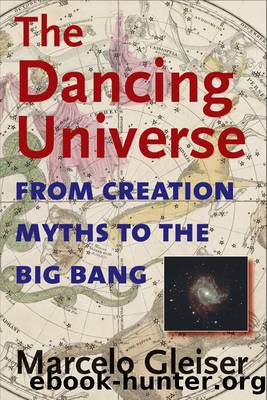The Dancing Universe by Marcelo Gleiser

Author:Marcelo Gleiser
Language: eng
Format: epub
ISBN: 9781611683950
Publisher: Dartmouth College Press
WAVES OF LIGHT
Storms conjure up all sorts of ancient fears. You may be a well-informed, late-twentieth-century person, in touch with the world through CNN and the Weather Channel, fully aware of natureâs unruly manifestations. But consider this situation: One beautiful summer afternoon, as you are leaving your office to go home, you notice a pleasant breeze blowing from the east. Soon the pleasant breeze turns into a furious wind, bringing in clouds from, it seems, all directions at once. An hour later, you donât know if itâs dark because of nightfall or because of the massive clouds. You remember, with a shudder, that at this time of the year it stays light until nine or so. You look up and wonder how heavy can clouds possibly get before they discharge. There is a brief moment of complete stillness. And then it starts.
Your house is under the attack of a heavy electrical storm. Lightning is flashing all around you, painting your walls with elusive ghostly blue shadows. Continuous thundering, loud to the point of deafening, eerily shakes your bed (yes, somehow you find yourself under the covers by now) and your wits. Water is pouring down from the heavens, without an indication of stopping. The power goes off (of course), you hear a terrible explosion, followed by a loud cracking sound; your beautiful two-hundred-year-old pine tree falls, consumed instantly by flames. All you can think about is the lightning rod while imploring to yourself, âPlease, please work!â
At least you have a lightning rod, or some other way to diffuse the potential damage of lightning. Imagine the havoc caused by electric storms before the invention of the lightning rod. We can thank none other than Benjamin Franklin (1706â1790) for this clever invention. In the summer of 1752, during a storm like the one I described above, Franklin decided to prove his thesis that lightning was related to electricity. As lightning started to appear, Franklin and his son boldly went outside to fly a silk kite. They had attached a metal key to the string, and noted that when âelectrical fireâ hit the wet kite, sparks flew off the dangling key. But if the kite was connected to the ground, the lightning would harmlessly discharge itself. The lightning rod was born.*
During the mid-eighteenth century, electricity was thought, just like heat, to be a fluid. Actually, because it was known that electrified objects can both attract and repel each other, electricity was thought to be made of two fluids. Apparently, Franklin was not aware of this two-fluid model of electricity and proposed a simpler, and more correct, one-fluid model. The so-called electric fluid was supposed to be present in every material body. When two bodies are rubbed against each other, some of this fluid is displaced. If an object gains fluid, it becomes positively charged; if it loses fluid, it becomes negatively charged. For example, if a glass rod is rubbed with a silk handkerchief, the rod becomes positively charged, while the silk becomes negatively charged.
Download
This site does not store any files on its server. We only index and link to content provided by other sites. Please contact the content providers to delete copyright contents if any and email us, we'll remove relevant links or contents immediately.
| Aeronautics & Astronautics | Astronomy |
| Astrophysics & Space Science | Comets, Meteors & Asteroids |
| Cosmology | Mars |
| Solar System | Star-Gazing |
| Telescopes | UFOs |
Tools of Titans by Timothy Ferriss(8308)
Turbulence by E. J. Noyes(7983)
Secrets of Antigravity Propulsion: Tesla, UFOs, and Classified Aerospace Technology by Ph.D. Paul A. Laviolette(5336)
Astrophysics for People in a Hurry by Neil DeGrasse Tyson(5153)
Room 212 by Kate Stewart(5073)
Design of Trajectory Optimization Approach for Space Maneuver Vehicle Skip Entry Problems by Runqi Chai & Al Savvaris & Antonios Tsourdos & Senchun Chai(5040)
Pale Blue Dot by Carl Sagan(4960)
The David Icke Guide to the Global Conspiracy (and how to end it) by David Icke(4659)
A Journey Through Divination and Astronomy by Publishing Pottermore(4364)
Goodbye Paradise(3767)
Apollo 8 by Jeffrey Kluger(3673)
COSMOS by Carl Sagan(3593)
The Five People You Meet in Heaven by Mitch Albom(3522)
Losing the Nobel Prize by Brian Keating(3521)
How to Read Water: Clues and Patterns from Puddles to the Sea (Natural Navigation) by Tristan Gooley(3434)
Brief Answers to the Big Questions by Stephen Hawking(3394)
How to Read Nature by Tristan Gooley(3294)
The Order of Time by Carlo Rovelli(3164)
A Brief History of Time by Stephen Hawking(2994)
